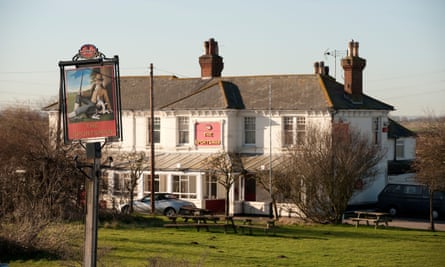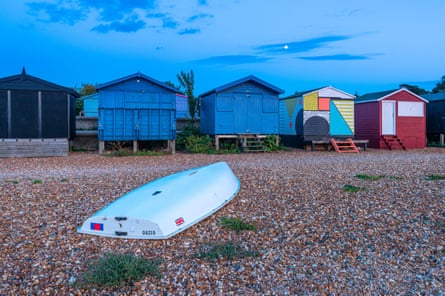
It takes over an hour to walk from Whitstable to the Sportsman, our pub in Seasalter on the north Kent coast, but we always say to allow a bit longer. It’s possible in less time but you don’t want to be running at the end and turning up at the restaurant red-faced.
Taking a more leisurely approach means you can make a few stops along the way. From the station (an hour and 15 minutes by train from St Pancras), walk down Cromwell Road and turn right onto Oxford Street, where you’ll find Grain and Hearth. This bakery serves amazing croissants and really good coffee – fuel for the walk ahead.
Whitstable is an old fishing town; oysters were harvested here in Roman times. Think clapperboard houses and old fisherman’s cottages, narrow streets and lots of pubs, some of them not much bigger than a front room. (For something stronger than coffee, head down to the Old Neptune by the beach. The floor is very wonky so you may feel like you’re already drunk, but the more you drink, the more level it will seem.) We’ve really seen Whitstable grow. In the 1980s it was quite a poor seaside town, with squats and student housing; now, terraced houses on Island Wall sell for millions.
From the bakery, turn left and left again onto West Cliff and walk through the golf course, then head left onto West Beach. There are lots of lovely beach huts along here, some of them quite brightly decorated – one is covered in shrimp, another is done up like a rainbow. Look out, too, for some interesting plants, such as viper’s-bugloss and yellow horned-poppies in early summer.
It’s a pebbly beach lined with timber groynes, which are designed to protect Whitstable from the sea. They’ve been renewed quite recently, but not the ones in Seasalter, and as you go further along you’ll see they’ve been beautifully eroded by the sea to create a sculptural effect.
Heading west on the beach, you’ll pass a row of mega-money houses on Preston Parade. They’re all quite different – some very modern, others a bit more clapperboard. There’s one that looks, to our eyes, like a giant baked-bean tin. You’ll see the back of a pub called The Oyster Pearl, and then Seasalter oyster fisheries. They don’t serve oysters to eat, but you might be able buy some wholesale. (We wouldn’t advise picking oysters or mussels off the beach, because they need to be treated first.)
If the tide’s out, you can see a wreck of an 18th-century ship out in the mud, which has been exposed by shifting sands and tides. Beware: it’s incredibly sinky mud and you’re likely to get stuck if you go out to investigate. There’s a graveyard of wellies out there.
Beyond the oyster fisheries, the beach gets a bit narrow so be careful – walk on the road momentarily if you need flatter ground, and you’ll see on your left the Seasalter Levels nature reserve, which is being renovated to boost biodiversity.
Those interested in foraging should keep an eye out for sea lettuce, which looks like a sheet of green acetate floating in the water but has a really great flavour – we dehydrate it and crumble it into our homemade butter to grill fish in, or scallops. Gutweed, a more fibrous, stringy green seaweed, is also really good. You’ll find tons of bladderwrack as well, which is not so good to eat, but it’s quite fun to pop the bubbles.
Out on the mud, on this stretch and all the way up to the Sportsman, you’ll see bait diggers when the tide is out. They go out in all weathers, at any time of day, to dig for lungworm. In the middle of the night, sometimes, they’ll be out there in their galoshes with buckets and forks.
To give your feet a rest from the pebbles, there are steps up onto the sea wall. From the top, there are good views out over the estuary to the Isle of Sheppey. On the other side, across the road, is the marsh. The sea wall was built in the 14th century to protect the land, which the monks used as a larder for Canterbury Cathedral – in the Domesday Book it says Seasalter “properly belongs to the kitchen of the archbishop” for fisheries and the pannage of hogs.
As you’re walking along the wall, there’s a grass bank on the left-hand side and, in spring and summer, it’s full of wildflowers. There’s so many different types, including wild carrot, clover, ox-eye daisies and meadow salsify, also known as Johnny-go-to-bed-at-noon because the flower closes up after midday. In the autumn, the reeds that line the marsh are really beautiful, with silvery, fluffy tips that sway in the breeze and catch the light.
The autumn also yields blackberries and beach roses. We use the petals for garnishing desserts and the hips for syrup to go with puddings and sometimes game. It’s worth looking out for birds of prey at this point. We’ve seen marsh harriers and sparrowhawks recently, and owls at twilight.

From the sea wall, you’ll see Waldens, a sweet little bucket-and-spade shop attached to the caravan park. Keep going past the Seasalter Sailing Club and the Sportsman will appear in the distance. It looks closer than it really is. You think, oh, we’re nearly there, but actually, it’s probably another 20 or 30 minutes.
If walking on the beach, come off just before the next row of beach huts. A rocky little path leads to the top of the bank, and then walk down the steps into our car park.
Everyone says the Sportsman’s not much from the outside – a scruffy, weather-beaten building in the middle of a marsh next to the sea. It’s all about the food really, and the service, too – we’re delighted to tell you about the dishes but we won’t interrupt if you’re having a conversation. The food is deceptively simple, but full of flavour and a real reflection of the terroir – of the beautifully rich landscape that you’ve just spent the past hour or so walking through.
Stay
There are cabins at the pub (£160 a night, with a continental breakfast provided in the room) for postprandial naps. There’s a wildflower meadow in the middle of the cabins which blooms in the spring. Book well ahead at the weekends and during peak season, but it’s not madly booked out otherwise. And there are tons of Airbnbs in Whitstable.
Stephen Harris and Emma Read are chef and front of house at the Sportsman pub in Seasalter



